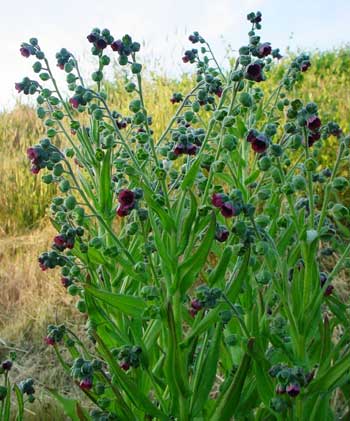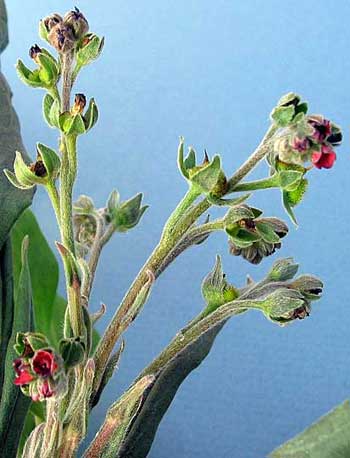Contents:
Common Names | Parts Usually Used | Plant(s) & Culture | Where Found | Medicinal Properties | Biochemical Information
Legends, Myths and Stories | Uses | Formulas or Dosages | Warning | Bibliography
Scientific Names

- Cynoglossum officinale L.
- Boraginaceae
- Borage family
Common Names
- Dog-bur
- Dog’s tongue
- Gypsy flower
- Sheep-lice
- Woolmat
Parts Usually Used
Root, herb, leaves
Back to Top

Description of Plant(s) and Culture
Hound’s tongue is a biennial weed; the erect stem, 1-3 feet high, bears alternate, sessile, lanceolate leaves that are downy on both sides. The basal leaves are similar but have petioles and are shaped somewhat like a dog’s tongue. The reddish-purple or lavender flowers have funnel-shaped corollas and grow in curving racemes from May to September. The bruised plant has a disagreeable, mousy or musty odor.
Another variety: Virginia mouse-ear (C. morrison) is a related annual plant similar in appearance to hound’s tongue but with white or light blue flowers. The root is an effective astringent.
Back to Top
Where Found
Grows in waste places, in sandy, rocky soil, and along roadsides in the states north and east of Montana and Kansas, as well as in Europe.
Back to Top
Medicinal Properties
Astringent, anodyne, anti-inflammatory, demulcent
Back to Top
Biochemical Information
Alkaloids, allantoin, heliosupin, tannins, essential oil and mucins
Back to Top
Legends, Myths and Stories
Webster’s Dictionary claims hound’s tongue is of the Borage family; some references state it should be the Forget-me-not family.
Legend has it that if the leaves are laid under their feet, it prevents dogs from barking. Hence the name.
According to The Herbalist Almanac, if hound’s tongue is gathered when the sap is full of vigor, bruise it with a hammer and lay it in the house, barn or granary that is infested with rats or mice. The rats and mice will “shift their quarters” so it is claimed.
Hound’s tongue is an escaped weed from the early Colonial gardens. It was brought to the United States from the Old World for its medicinal properties.
Back to Top
Uses
Primarily used for diarrhea and dysentery. But also used for coughs, catarrh, indigestion, colic, chronic bronchitis, neuritis, neuralgia, colds, and lung problems. Externally, used for burns, bruises, scratches, insect bites, snakebites, piles, tumors, scrofula, abrasions, boils, goiters, and difficult wounds, but its effectiveness has been questioned. Culpeper claimed that he cured rabies from the bite of a mad dog with this herb.
Back to Top
Formulas or Dosages
Use the dried herb or root. Gather the root in spring, the herb in early summer.
Infusion: steep 1 tsp. dried root or herb in 1 cup water. Take 1 tbsp. per day. May be sweetened with honey. Do not exceed 1 tbsp. per day dosage, as the plant has marked narcotic tendencies.
Back to Top
Warning
Hound’s tongue is weakly poisonous and should be taken with care. The plant has marked narcotic tendencies. Contains the potentially carcinogenic alkaloids, cynoglossine and consolidine, both central nervous system depressants.
It may also cause dermatitis in susceptible individuals.
Use only under medical supervision.
Back to Top
Bibliography
![]() Culpeper’s Complete Herbal & English Physician: Updated With 117 Modern Herbs
Culpeper’s Complete Herbal & English Physician: Updated With 117 Modern Herbs, by Nicholas Culpeper, Meyerbooks, publisher, PO Box 427, Glenwood, Illinois 60425, 1990, (reprint of 1814)
![]() Eastern/Central Medicinal Plants
Eastern/Central Medicinal Plants, by Steven Foster and James A. Duke., Houghton Mifflin Company, 215 Park Avenue South, New York, NY 10000
![]() The Herbalist Almanac
The Herbalist Almanac, by Clarence Meyer, Meyerbooks, publisher, PO Box 427, Glenwood, Illinois 60425, copyright 1988, fifth printing, 1994
![]() The Herb Book
The Herb Book, by John Lust, Bantam Books, 666 Fifth Avenue, New York, NY. copyright 1974.
![]() Indian Herbalogy of North America
Indian Herbalogy of North America, by Alma R. Hutchens, Shambala Publications, Inc., Horticultural Hall, 300 Massachusetts Avenue, Boston, Massachusetts 02115, 1973
 The Magic of Herbs
The Magic of Herbs, by David Conway, published by Jonathan Cape, Thirty Bedford Square, London, England. (Out of print)
![]() Planetary Herbology
Planetary Herbology, by Michael Tierra, C.A., N.D., O.M.D., Lotus Press, PO Box 325, Twin Lakes. WI 53181., Copyright 1988, published 1992
![]() Webster’s New World Dictionary
Webster’s New World Dictionary, Third College Edition, Victoria Neufeldt, Editor in Chief, New World Dictionaries: A Division of Simon & Schuster, Inc., 15 Columbus Circle, New York, NY 10023
 The Rodale Herb Book: How to Use, Grow, and Buy Nature’s Miracle Plants (An Organic gardening and farming book)
The Rodale Herb Book: How to Use, Grow, and Buy Nature’s Miracle Plants (An Organic gardening and farming book), edited by William H. Hylton, Rodale Press, Inc. Emmaus, PA, 18049., 1974
